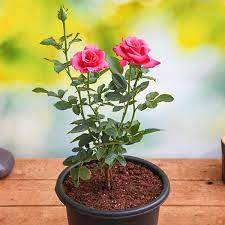Caring for rose bushes is an art that requires attention to detail, dedication, and a nurturing touch. Roses, beloved for their beauty, fragrance, and symbolism, flourish when provided with the right conditions and proper care. Whether you’re cultivating hybrid tea roses, floribundas, climbers, or shrub varieties, here’s an extensive guide covering every aspect of rose bush care to help you nurture these stunning plants.
1. Choosing the Right Location:
a. Sunlight: Select a spot that receives at least six hours of sunlight daily. Roses thrive in full sun, which promotes robust growth and abundant flowering. Ensure adequate airflow to prevent diseases.
b. Soil Conditions: Roses prefer well-draining soil rich in organic matter. Conduct a soil test to determine pH levels; they generally prefer slightly acidic soil (pH 6.0-6.5). Improve soil quality with compost or aged manure.
c. Planting: Dig a hole twice the width of the root ball and slightly deeper. Place the rose bush in the hole, spread out the roots, and backfill with soil. Water thoroughly after planting to help settle the soil.
2. Watering Practices:
a. Consistent Moisture: Roses require consistent moisture, especially during the growing season. Water deeply, ensuring the soil is moist but not waterlogged. Aim for around an inch of water weekly, adjusting based on weather conditions.
b. Morning Watering: Water in the morning to allow foliage to dry during the day, reducing the risk of fungal diseases. Avoid overhead watering to prevent wet foliage, which can lead to diseases like powdery mildew.
3. Feeding and Fertilizing:
a. Balanced Fertilizer: Use a balanced fertilizer formulated for roses. Apply according to package instructions, usually in spring after pruning and again in early summer. Avoid over-fertilizing as it can lead to excessive foliage growth at the expense of blooms.
b. Organic Nutrients: Incorporate compost or well-decomposed manure around the base of the rose bush in spring to enrich the soil and provide organic nutrients. Mulch with organic matter to retain moisture and suppress weeds.
4. Pruning Techniques:
a. Seasonal Pruning: Prune rose bushes in late winter or early spring before new growth emerges. Remove dead, damaged, or crossing branches. Trim to shape the bush and encourage airflow, reducing the risk of diseases.
b. Deadheading: Regularly remove spent blooms to encourage continuous flowering and prevent the plant from diverting energy to seed production. Cut just above a leaflet with a slanting cut to encourage outward growth.
c. Training and Shaping: Train climbing roses by securing canes to supports and pruning to encourage lateral growth. Shape shrub roses to maintain an open center for good air circulation.
5. Mulching and Protection:
a. Mulching Benefits: Apply a layer of organic mulch around the base of the rose bush to retain moisture, regulate soil temperature, and suppress weeds. Mulch also helps prevent soil splashing, reducing the risk of diseases.
b. Winter Protection: In colder climates, protect rose bushes from freezing temperatures by adding extra mulch around the base and gently wrapping the plant with burlap or specialized covers.
6. Pest and Disease Management:
a. Regular Monitoring: Inspect rose bushes regularly for signs of pests like aphids, spider mites, or diseases such as black spot or rust. Early detection allows for prompt intervention.
b. Integrated Pest Management (IPM): Employ IPM techniques, including using beneficial insects, horticultural oils, insecticidal soaps, or organic fungicides to manage pests and diseases while minimizing harm to beneficial organisms.
7. Support and Training:
a. Staking and Support: Young rose bushes may require staking or support to prevent bending or damage. Use stakes and ties to secure the plant until it establishes strong roots.
b. Training Climbers: Train climbing roses by gently guiding canes along supports, encouraging them to grow horizontally for better coverage and increased flowering.
8. Disease Prevention:
a. Sanitation: Maintain cleanliness in the garden by removing fallen leaves and debris, as these can harbor pests and diseases. Prune and dispose of infected parts to prevent the spread of diseases.
b. Good Air Circulation: Proper spacing between rose bushes encourages good air circulation, reducing the risk of fungal diseases like powdery mildew or black spot.
9. Rejuvenation and Renewal:
a. Renewal Pruning: Every few years, consider more aggressive pruning, known as renewal pruning, to rejuvenate older rose bushes. This stimulates new growth and enhances overall plant health.
b. Propagating Roses: Propagate favorite rose varieties through cuttings or grafting to rejuvenate a plant or create new ones. This helps maintain prized cultivars and expand your rose collection.

